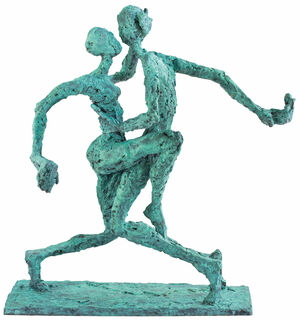Sculpture "Harmony" (2021), bronze
Sculpture "Harmony" (2021), bronze
Quick info
ars mundi Exclusive Edition | limited, 30 copies | numbered | signed | hallmarked | certificate | bronze | chased | patinated | size 35 x 34 x 21 cm (h/w/d) | weight approx. 8.5 kg
Video
Detailed description
Sculpture "Harmony" (2021), bronze
Sculpture in fine bronze, cast using the Lost-Wax-Process, chiselled and patinated by hand. Taken directly from the original wax model. Limited edition of 30 copies, numbered, signed and hallmarked with the foundry seal and ars mundi stamp. Includes a numbered certificate of authenticity and limitation. Size 35 x 34 x 21 cm (h/w/d). Weight approx. 8.5 kg. ars mundi Exclusive Edition.

About Helge Leiberg
Helge Leiberg, born in Dresden, Germany in 1954, studied at the Dresden Academy of Fine Arts. Music is a recurring theme in the work of the multimedia artist, who realised numerous musical projects with A. R. Penck, among others.
Helge Leiberg's world of pictures and sculptures consists of symbolic figures that are slender, with overlong limbs and expansive gestures. Their dancing gestures express pure life: sometimes oblivious, sometimes interacting, they express affection and aversion, struggle and union. His masterly line management and virtuoso depiction of movement characterise his work. Leiberg draws inspiration from the influence of painting, dance and music. He played in a band with A.R. Penck and realised performances with Christa Wolf at the Salzburg Festival.
In 2023, he will receive the honorary prize of the Brandenburg Minister-President as part of the Brandenburg Art Prize, which is awarded by the Märkische Oderzeitung and the Stiftung Schloss Neuhardenberg.
Helge Leiberg was awarded the Brandenburg Art Prize for Painting in 2013. His works can be found in the Prussian Cultural Heritage Foundation as well as in the Würth Collection.
An alloy of copper with other metals (especially with tin) used since ancient times.
When casting bronze, the artist usually applies the lost-wax technique which is dating back more than 5000 years. It's the best, but also the most complex method of producing sculptures.
First, the artist forms a model of his sculpture. It is embedded in a liquid silicone rubber mass. Once the material has solidified, the model is cut out. The liquid wax is poured into the negative mould. After cooling down, the wax cast is removed from the mould, provided with sprues and dipped into ceramic mass. The ceramic mass is hardened in a kiln, whereby the wax flows out (lost mould).
Now we finally have the negative form, into which the 1400° C hot molten bronze is poured. After the bronze had cooled down, the ceramic shell is broken off and the sculpture is revealed.
Now the sprues are removed, the surfaces are polished, patinated and numbered by the artist himself or, to his specifications, by a specialist. Thus, each casting becomes an original work.
For lower-quality bronze castings, the sand casting method is often used which, however, does not achieve the results of a more complex lost-wax technique in terms of surface characteristics and quality.
Graphic or sculpture edition that was initiated by ars mundi and is available only at ars mundi or at distribution partners licensed by ars mundi.
Term for an art object (sculpture, installation), which is produced in multiple copies in a limited and numbered edition according to the artist‘s will.
Artist's multiples have been called the most accessible and affordable art on the market.
A plastic work of sculptural art made of wood, stone, ivory, bronze or other metals.
While sculptures from wood, ivory or stone are made directly from the block of material, in bronze casting a working model is prepared at first. Usually, it is made of clay or other easily mouldable materials.
The prime time of sculpture after the Greek and Roman antiquity was the Renaissance. Impressionism gave a new impulse to the sculptural arts. Contemporary artists such as Jorg Immendorf, Andora, and Markus Lupertz also enriched sculptures with outstanding works.






